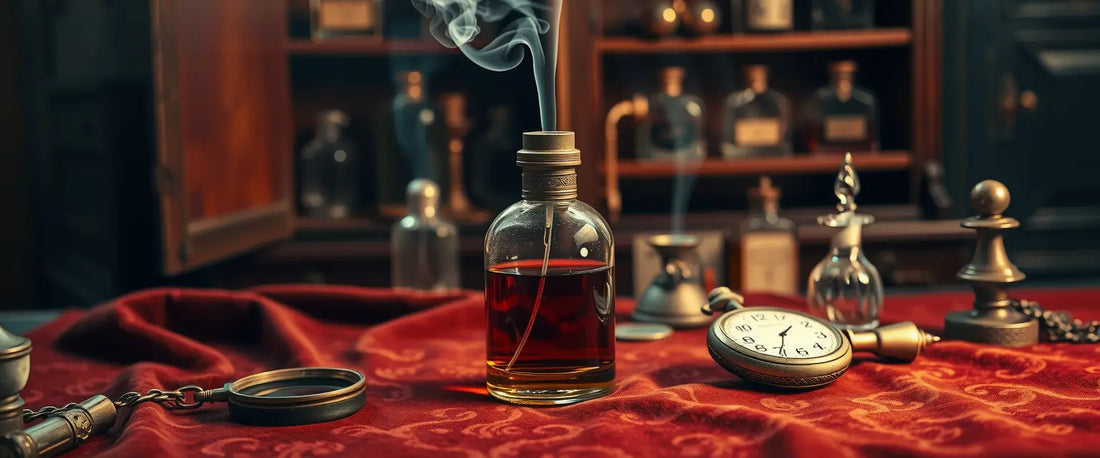
The hidden side of perfume: how and why to properly store a vintage fragrance
Share
Estimated reading time: 8 minutes
🧭 How to properly store perfumes (especially vintage ones)
Perfumes aren't immortal: they're fragile elixirs that react to light, heat, humidity, and oxygen. Improper storage can compromise their fragrance, balance, and collectible value—especially if they're rare or discontinued vintage perfumes .
🎯 The aim of this guide is to offer you best practices for optimally preserving modern and vintage fragrances, reducing degradation factors and maximizing their shelf life.
📖 Discover the most delicate olfactory families and how to protect them
🧪 Chapter 1: What Ruins a Perfume?
There are four main enemies of olfactory longevity: light, heat, humidity and oxygen.
| Factor | Effect | Solution |
|---|---|---|
| ☀️ Light | Destroys volatile molecules, alters color | Store in dark boxes or cupboards |
| 🔥 Heat | Increases internal pressure and accelerates oxidation | Maintain a constant 15–18°C |
| 💧 Humidity | Promotes mold and damages labels | Dry environment: 45–55% humidity |
| 🌀 Oxygen | Oxidizes the concentrate, making it unstable | Close the bottle tightly and reduce exposure to air. |
🔗 Related insights
A guide to perfume concentration to better understand how concentration relates to preservation: 👉 EdC, EdT, EdP and Parfum: differences
🧊 Chapter 2: Where to store them (and where absolutely NOT to)
The place of storage makes the difference between a fragrance still intact after 20 or more years and one completely altered.
| ❌ Place to avoid | Why is it dangerous? |
|---|---|
| Bath | Hot, humid, with sudden changes in temperature and water vapor |
| Exposed shelves | Even indirect light degrades the jus over time |
| Kitchen refrigerator | Too much humidity, risk of internal condensation and thermal shock |
| ✅ Recommended location | Advantages |
|---|---|
| Internal wooden wardrobe | Stable temperature, absence of light and humidity |
| Anti-UV boxes | Total protection from light, ideal for extrait |
| Mini wine cellars (at 15°C) | Optimal temperature and humidity control |
💼 Chapter 3: Large formats, maximum yield: why choose large bottles
🧴 Why do larger bottles keep better?
An often overlooked but scientifically sound claim has long been circulating among perfume enthusiasts: large bottles tend to preserve fragrances better over time . Let's explore why this happens and what advantages it offers, especially for valuable, vintage, or discontinued perfumes.
1. 📉 Lower air/liquid ratio = less oxidation
When we use a spray perfume, each spray allows a small amount of air to enter the bottle, which over time increases the liquid's exposure to oxygen. This inevitably leads to the oxidation of the aromatic molecules , with sometimes irreversible effects on the more volatile and delicate notes.
In small bottles (e.g., 30 ml or 50 ml), the percentage of air in relation to the liquid content increases much more rapidly than in 100 ml or 200 ml bottles. Consequently, perfumes in larger bottles oxidize more slowly , maintaining their olfactory nuances intact for longer.
2. 🌡️ Greater thermal inertia
Another little-considered advantage is thermal stability . Larger bottles, holding more liquid, tend to be less affected by sudden temperature changes . In physics, this is known as "thermal inertia": the more mass a body has, the slower it heats up or cools down.
Considering that thermal changes are one of the main enemies of scented formulas, this “protective” effect makes larger formats particularly suitable for long-term storage.
3. 💨 Slower evaporation of volatile components
Proportionately, a larger bottle exposes a smaller surface area of the liquid to the air each time it's opened or sprayed. This means that the lighter molecules—those that make up the top and part of the heart notes— evaporate more slowly , maintaining the fragrance's original balance for longer.
🧠 Professional advice
-
For fragrances you love and use often , choose 100 ml or larger sizes: they will guarantee not only a better quality/price ratio, but also a longer-lasting formula.
-
If you buy rare, collectible or vintage perfumes , choosing a large bottle can represent a real form of “protection” of your olfactory heritage.
-
Avoid unnecessary decanting : moving perfume from one container to another introduces air and increases the risk of contamination. It's best to store perfume in its original bottle with its sealing system.
Ultimately, choosing a larger bottle is not just an aesthetic or economic choice, but also a functional one : it helps prolong the life of your favorite perfume and preserve its olfactory signature over time.
💎 Chapter 4: Vintage VS Modern — Do They React the Same Way?
| Typology | Stability | Sensitivity | Most vulnerable notes |
|---|---|---|---|
| 📜 Vintage (pre-2000) | High if well preserved | Very high in light and heat | Citrus, aldehydes, floral top notes |
| 🧪 Modern (2000+) | Medium-high thanks to synthetics | Average | Marine, ozonated and fruity notes |
| 🎨 Niche/artistic | Variable, depends on the laboratory | High for natural formulas | Natural notes of flowers and spices |
The advice is always to treat vintage items with even greater care and never expose them to heat sources or direct light.
🔍 Chapter 5: How to Recognize a Altered Perfume
- Darker or amber color than the original
- Presence of sediment, turbidity or phase separation
- Top notes absent or flat
- Rancid, vinegary, or metallic odor
- Abnormal persistence (disappears immediately or does not evolve)
📖 Want to learn more about this topic? We'll soon publish a dedicated article with practical examples and advanced tips.
In the meantime, check out our official blog for more exclusive content and visit us often to stay up to date on news, guides, and tips.
🛠️ Chapter 6: Advanced Techniques for Collectors
Those who collect rare perfumes know that caring for them goes far beyond simply storing them in a drawer. Here are some professional strategies:
- Environmental control: use of humidifiers/dehumidifiers to maintain the ideal microclimate
- Temperature Monitoring: Indoor Thermometers to Avoid Temperature Fluctuations
- Additional sealing: parafilm or protective films on the cap to prevent air infiltration
- Cataloguing: record purchase date, storage conditions and any openings to monitor the status
🔚 Conclusion
A well-preserved perfume isn't just a fragrance: it's a piece of history, a lasting memory. Respecting its needs means prolonging its soul, so you can wear it today, tomorrow, and thirty years from now—or more.
✨ Looking for perfectly preserved vintage perfumes? Explore our ScentX Shop —only guaranteed rarities, carefully curated by enthusiasts for enthusiasts.
